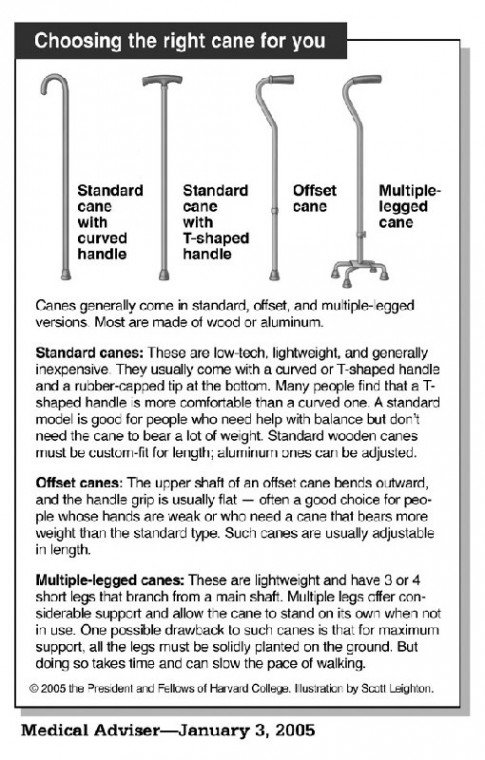Q: I’m having hip surgery next month. My doctor suggests using a
cane for support as I heal afterward. What should I know about
walking aids before I do so?
Q: I’m having hip surgery next month. My doctor suggests using a cane for support as I heal afterward. What should I know about walking aids before I do so?
A: Hip surgery is a major procedure, and you need to do everything you can to help your bones and muscles heal, and to safeguard yourself against falling. Canes can help protect against falls in people who are unsteady on their feet due to arthritis or other problems.
A simple cane can perform some complex functions. It redistributes weight to improve stability, helps reduce demand on muscles that may be weak, and takes the load off weight-bearing joints, such as the hip, knee and spine.
Research also suggests that the simple contact between the fingers and the cane can improve balance.
Canes are available at medical supply stores and pharmacies, through specialty catalogs, and on the Internet. Physical or occupational therapists can often recommend suppliers or products.
They can also help you select a cane, make sure it’s the proper length, and show you how to use it. Government or private insurance usually covers the cost of a basic cane if you have a written prescription from your primary care provider.
Try different handle designs to see which is easiest to grip and feels most comfortable when you walk. Avoid metal handles, which can be slippery when you perspire and too cold to touch on wintry days.
The traditional curved handle places the hand directly over the cane tip, which improves balance. A T-handle may help steady you even more. Offset handles are helpful if your hand is weak. Custom-molded grips can be made for hands that are misshapen — for example, by arthritis. A curved handle allows a cane to be hung over an arm or the back of a chair when not in use.
Here’s how to tell if a cane is the correct length for you. Stand up straight, wearing shoes that you’ll use for walking, and let your arms hang at your sides.
With the bottom of the cane planted firmly on the floor, the top should come to the inside of the wrist (where the palm meets the wrist) of the hand you’ll be using to hold your cane.
To fit a cane that you already own, remove the rubber tip and turn the cane upside down, resting the handle on the floor.
Have someone mark the place on the cane’s shaft that is level with your wrist.
Wooden canes can be sawed to the correct length, but be sure that the rubber end is attached firmly to the bottom. You can adjust most aluminum or fiberglass models using a button on the shaft.
Many people don’t realize that you should hold a cane with the hand that is on the opposite side of the leg that needs support, with the bottom planted about 4 inches to the side of your stronger leg. Why is that?
Imagine that your right leg is weak. When you walk, your weight shifts between your strong left leg and your weak right leg.
It’s when you put weight on your weak right leg that you need to support your body from falling. You do that by having some of your weight supported by the weak right leg, and the rest supported by your left arm and hand — using the cane.
For those just beginning to use a cane, place the cane tip a few inches ahead of you, then bring the weaker leg forward so it’s even with the cane.
The cane helps support your weight. Now move your stronger leg up even with the cane, and start the sequence over again.
This series of steps looks like the wedding march.
As you gain more experience, move the cane and your weak leg forward together, so they strike the ground at the same time, bearing your weight on the stronger leg.
Using your cane to keep your weight off the weak leg, move your stronger leg forward, stepping beyond the cane tip. Repeat the sequence.
There are also alternatives to canes, such as crutches, walkers and wheelchairs. Crutches are a little harder to learn how to use than a cane, but many people prefer them because crutches are for young and old alike.
Though less potentially youthful-looking than crutches, walkers and wheelchairs are easier for some people to use than canes. A physical therapist can determine the best walking aid for you.
Some people are reluctant to use a cane because they feel it makes them look old or infirm.
But getting up and moving is one of the best ways to prevent further injury or disability and promote health. Don’t let self-consciousness about using a cane threaten your independence.
Submit questions to the Harvard Medical School Adviser at www.health.harvard. edu/adviser. Unfortunately, personal responses are not possible.















